
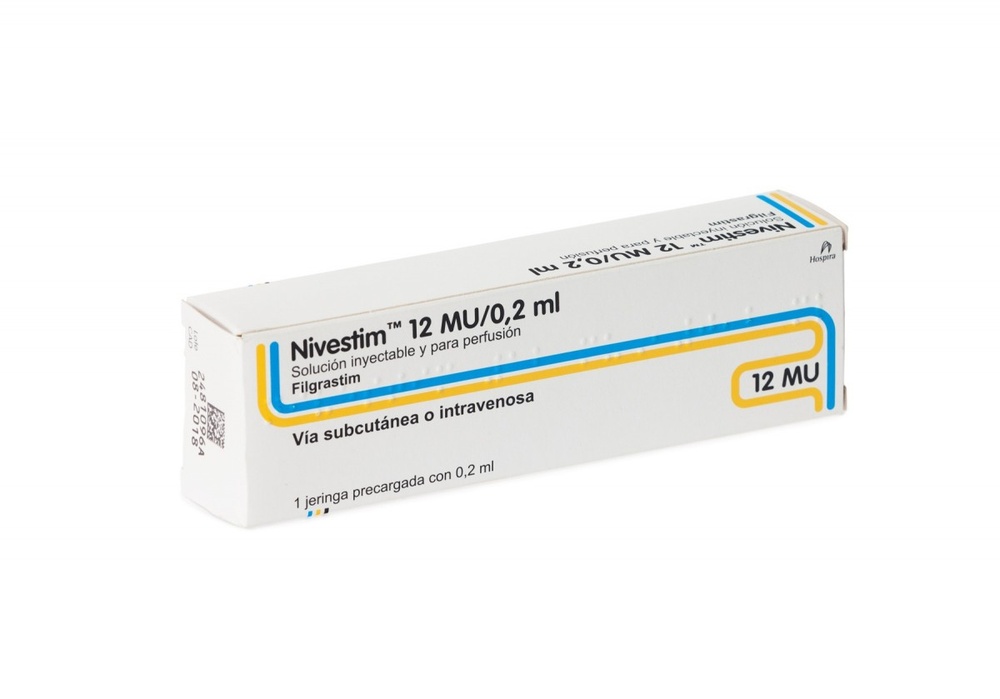
НИВЕСТИМ 12 МЕ/0,2 мл РАСТВОР ДЛЯ ИНЪЕКЦИЙ ИЛИ ДЛЯ ПЕРФУЗИИ


Инструкция по применению НИВЕСТИМ 12 МЕ/0,2 мл РАСТВОР ДЛЯ ИНЪЕКЦИЙ ИЛИ ДЛЯ ПЕРФУЗИИ
Введение
Проспект: информация для пользователя
Нивестим 12МЕ/0,2мл раствор для инъекции и инфузии
Нивестим 30МЕ/0,5мл раствор для инъекции и инфузии
Нивестим 48МЕ/0,5мл раствор для инъекции и инфузии
филграстим
Прочитайте внимательно весь проспект перед началом использования лекарственного средства, поскольку он содержит важную информацию для вас.
- Сохраните этот проспект, поскольку вам может потребоваться прочитать его снова.
- Если у вас есть какие-либо вопросы, проконсультируйтесь с вашим врачом, медсестрой или фармацевтом.
- Это лекарственное средство было назначено только вам, и не передавайте его другим людям, даже если у них такие же симптомы, как у вас, поскольку оно может нанести им вред.
- Если вы испытываете побочные эффекты, проконсультируйтесь с вашим врачом, фармацевтом или медсестрой, даже если это побочные эффекты, которые не указаны в этом проспекте. См. раздел 4.
Содержание проспекта
- Что такое Нивестим и для чего он используется
- Что нужно знать перед началом использования Нивестима
- Как использовать Нивестим
- Возможные побочные эффекты
- Хранение Нивестима
- Содержание упаковки и дополнительная информация
1. Что такое Нивестим и для чего он используется
Нивестим является фактором роста белых кровяных телец (фактором стимуляции колоний гранулоцитов) и принадлежит к группе лекарственных средств, называемых цитокинами. Факторы роста - это белки, которые производятся естественным образом в организме, но также могут быть произведены с помощью генной инженерии для использования в качестве лекарственного средства. Нивестим работает, стимулируя костный мозг к производству большего количества белых кровяных телец.
Снижение количества белых кровяных телец (нейтропения) может произойти по различным причинам и делает ваш организм менее эффективным в борьбе с инфекциями. Нивестим стимулирует костный мозг к быстрому производству новых белых кровяных телец.
Нивестим можно использовать:
- для увеличения количества белых кровяных телец после лечения химиотерапией, чтобы помочь предотвратить инфекции;
- для увеличения количества белых кровяных телец после трансплантации костного мозга, чтобы помочь предотвратить инфекции;
- до высокой дозы химиотерапии, чтобы стимулировать костный мозг к производству большего количества стволовых клеток, которые могут быть собраны и введены обратно вам после лечения. Эти клетки могут быть собраны у вас или у донора. Стволовые клетки затем вернутся в костный мозг и произведут кровяные клетки;
- для увеличения количества белых кровяных телец, если вы страдаете от тяжелой хронической нейтропении, чтобы помочь предотвратить инфекции;
- для помощи в снижении риска инфекций у пациентов с продвинутой инфекцией ВИЧ.
2. Что нужно знать перед началом использования Нивестима
Не используйте Нивестим
- если вы аллергичны к филграстиму или к любому другому компоненту этого лекарственного средства (перечисленному в разделе 6).
Предостережения и меры предосторожности
Проконсультируйтесь с вашим врачом, фармацевтом или медсестрой перед началом использования Нивестима.
Сообщите вашему врачу перед началом лечения если вы страдаете:
- анемией клеток-серпент (серповидно-клеточной анемией), поскольку Нивестим может вызвать кризис серповидно-клеточной анемии;
- остеопорозом (болезнью костей).
Сообщите вашему врачу немедленно во время лечения Нивестимом, если:
- у вас появляются внезапные признаки аллергии, такие как сыпь, зуд или крапивница на коже, отек лица, губ, языка или других частей тела, одышка, свистящее дыхание или проблемы с дыханием, поскольку это могут быть признаки тяжелой аллергической реакции (гиперчувствительности);
- вы испытываете отек лица или лодыжек, кровь в моче или моча коричневого цвета, или если вы заметили, что мочитесь реже, чем обычно (гломерулонефрит);
- вы испытываете боль в верхней левой части живота (абдоминальную), боль под левой стороной грудной клетки или в конце левого плеча (это могут быть симптомы увеличенной селезенки [спленомегалии] или возможного разрыва селезенки);
- вы заметили кровотечение или синяки (это могут быть симптомы снижения количества тромбоцитов в крови [тромбоцитопении], с уменьшенной способностью крови к свертыванию).
- Редко сообщалось об воспалении аорты (большой кровеносной сосуд, переносящей кровь от сердца к остальной части тела) у пациентов с раком и у здоровых доноров. Симптомы могут включать лихорадку, абдоминальную боль, общее недомогание, боль в спине и повышенные воспалительные маркеры. Сообщите вашему врачу, если у вас появляются эти симптомы.
Потеря ответа на филграстим
Если вы испытываете потерю ответа или если не удается поддерживать ответ на лечение филграстимом, ваш врач будет исследовать причины, включая возможность того, что вы развили антитела, которые могут нейтрализовать активность филграстима.
Ваш врач может захотеть внимательно следить за вами, см. раздел 4 проспекта.
Если вы являетесь пациентом с тяжелой хронической нейтропенией, вы можете быть в группе риска развития рака крови (лейкемии, миелодиспластического синдрома [МДС]). Поговорите с вашим врачом о рисках развития рака крови и о тестах, которые необходимо провести. Если вы разовьете или, вероятно, разовьете рак крови, не должны использовать Нивестим, если только ваш врач не назначит.
Если вы являетесь донором стволовых клеток, вам должно быть от 16 до 60 лет.
Будьте особенно осторожны с другими продуктами, стимулирующими белые кровяные тельца
Нивестим принадлежит к группе лекарственных средств, стимулирующих производство белых кровяных телец. Ваш врач всегда должен регистрировать точный продукт, который вы используете.
Использование Нивестима с другими лекарственными средствами
Сообщите вашему врачу или фармацевту, если вы принимаете, недавно принимали или можете принимать любое другое лекарственное средство.
Беременность и лактация
Нивестим не изучался у беременных или кормящих женщин.
Не рекомендуется использовать Нивестим во время беременности.
Важно, чтобы вы сообщили вашему врачу, если:
- вы беременны или кормите грудью;
- вы считаете, что можете быть беременной; или
- вы планируете забеременеть.
Если вы забеременеете во время лечения Нивестимом, сообщите вашему врачу.
Если только ваш врач не назначит иное, вы должны прекратить кормить грудью, если используете Нивестим.
Вождение и использование машин
Влияние Нивестима на вашу способность управлять транспортными средствами и работать с машинами является небольшим. Это лекарственное средство может вызывать головокружение. Рекомендуется подождать и увидеть, как вы себя чувствуете после введения Нивестима, прежде чем управлять транспортными средствами или работать с машинами.
Нивестим содержит натрий
Это лекарственное средство содержит менее 1 ммоль натрия (23 мг) на дозу 0,6 мг/мл или 0,96 мг/мл; это означает, что оно практически не содержит натрия.
Нивестим содержит сорбитол
Это лекарственное средство содержит 50 мг сорбитола в каждом мл.
Сорбитол является источником фруктозы. Если вы (или ваш ребенок) страдаете врожденной непереносимостью фруктозы (ВНФ), редким генетическим заболеванием, не должны получать это лекарственное средство. Пациенты с ВНФ не могут расщеплять фруктозу, что может привести к тяжелым побочным эффектам.
Проконсультируйтесь с вашим врачом перед получением этого лекарственного средства, если вы (или ваш ребенок) страдаете ВНФ или если ваш ребенок не может принимать сладкие продукты или напитки, поскольку они вызывают у него головокружение, рвоту или неприятные эффекты, такие как вздутие, спазмы в животе или диарею.
3. Как использовать Нивестим
Следуйте точно инструкциям по введению этого лекарственного средства, указанным вашим врачом. В случае сомнений проконсультируйтесь с вашим врачом, медсестрой или фармацевтом.
Как вводится Нивестим и сколько нужно принимать?
Нивестим обычно вводится один раз в день в виде инъекции в ткань непосредственно под кожей (известной как подкожная инъекция). Он также может быть введен один раз в день в виде медленной инфузии в вену (известной как внутривенная инфузия). Обычная доза варьируется в зависимости от вашего заболевания и веса. Ваш врач укажет вам количество Нивестима, которое вам нужно принимать.
Пациенты с трансплантацией костного мозга после химиотерапии:
Обычно вы получите первую дозу Нивестима не менее чем через 24 часа после химиотерапии и не менее чем через 24 часа после трансплантации костного мозга.
Вам или людям, которые за вами ухаживают, может быть обучено введению подкожных инъекций, чтобы вы могли продолжать лечение дома. Однако не должны пытаться сделать это, если только ваш медицинский работник не обучил вас должным образом.
Как долго мне нужно принимать Нивестим?
Вам нужно будет принимать Нивестим до тех пор, пока количество белых кровяных телец не станет нормальным. У вас будут проводиться периодические анализы крови, чтобы контролировать количество белых кровяных телец в вашем организме. Ваш врач укажет, сколько времени вам нужно принимать Нивестим.
Использование у детей
Нивестим используется для лечения детей, получающих химиотерапию или страдающих от низкого количества белых кровяных телец (нейтропении) тяжелой степени. Доза у детей, получающих химиотерапию, такая же, как и у взрослых.
Если вы примете больше Нивестима, чем нужно
Не увеличивайте дозу, назначенную вашим врачом. Если вы считаете, что ввели больше дозы, чем должно быть, свяжитесь с вашим врачом как можно скорее.
Если вы забыли использовать Нивестим
Если вы забыли сделать инъекцию или если вы ввели меньше дозы, свяжитесь с вашим врачом как можно скорее. Не принимайте двойную дозу, чтобы компенсировать пропущенные дозы.
Если у вас есть какие-либо вопросы о использовании этого лекарственного средства, проконсультируйтесь с вашим врачом, медсестрой или фармацевтом.
4. Возможные побочные эффекты
Как и все лекарственные средства, это лекарственное средство может вызывать побочные эффекты, хотя не все люди испытывают их.
Сообщите вашему врачу немедленново время лечения:
- если вы испытываете аллергическую реакцию, включая слабость, падение артериального давления, трудности с дыханием, отек лица, губ, языка или других частей тела, одышку, свистящее дыхание или проблемы с дыханием, поскольку это могут быть признаки тяжелой аллергической реакции (анafilаксии), сыпи, зуда или крапивницы на коже, отека лица, губ, рта, языка или горла (ангioneдемы) и одышки (диспноэ);
- если вы испытываете кашель, лихорадку и трудности с дыханием (диспноэ), поскольку это может быть признаком острого респираторного дистресс-синдрома (ОРДС);
- если вы испытываете повреждение почек (гломерулонефрит). Повреждение почек было отмечено у пациентов, получавших филграстим. Свяжитесь с вашим врачом немедленно, если вы заметите отек лица или лодыжек, кровь в моче или мочу коричневого цвета, или если вы заметили, что мочитесь реже, чем обычно;
- если вы испытываете любой из следующих побочных эффектов или их комбинацию:
- отек, который может быть связан с мочеиспусканием реже, чем обычно, трудностями с дыханием, отеком и чувством наполнения в животе, и общим чувством усталости. Эти симптомы обычно развиваются очень быстро.
Это могут быть симптомы заболевания, называемого "синдромом капиллярного пропуска", которое вызывает выход крови из небольших кровеносных сосудов в другие части вашего организма и требует срочной медицинской помощи.
- Если вы испытываете комбинацию следующих симптомов:
- лихорадку, озноб, чувство сильного холода, высокую частоту сердечных сокращений, спутанность сознания или дезориентацию, трудности с дыханием, сильную боль или дискомфорт и влажную или потную кожу.
Это могут быть симптомы состояния, называемого "сепсисом" (также называемого "бактериемическим шоком"), тяжелой инфекции с воспалительной реакцией всего организма, которая может быть потенциально смертельной и требует срочной медицинской помощи.
- если вы испытываете боль в верхней левой части живота (абдоминальную), боль под левой стороной грудной клетки или боль в конце левого плеча, поскольку это может быть связано с проблемами селезенки (увеличенной селезенкой [спленомегалией] или разрывом селезенки);
- если вы лечитесь от тяжелой хронической нейтропении и имеете кровь в моче (гематурию). Ваш врач будет проводить периодические анализы мочи, если вы испытываете этот побочный эффект или если в вашей моче обнаружены белки (протеинурия).
Частым побочным эффектом использования филграстима является боль в мышцах или костях (мышечно-скелетная боль), которую можно предотвратить, принимая обычные обезболивающие препараты (анальгетики). У пациентов, подвергающихся трансплантации стволовых клеток или костного мозга, может развиться болезнь трансплантата против хозяина (БТГ); это реакция донорских клеток против пациента, получающего трансплантат; признаки и симптомы включают сыпь на ладонях или подошвах, и язвы или раны во рту, кишечнике, печени, коже, глазах, легких, влагалище и суставах.
У здоровых доноров стволовых клеток может наблюдаться увеличение количества белых кровяных телец (лейкоцитоз) и снижение количества тромбоцитов. Это снижает способность крови к свертыванию (тромбоцитопению). Эти эффекты будут контролироваться вашим врачом.
Очень частые побочные эффекты(могут возникать более чем у 1 из 10 человек):
- Снижение количества тромбоцитов, что снижает способность крови к свертыванию (тромбоцитопения)
- Низкое количество красных кровяных телец (анемия)
- Головная боль
- Диарея
- Рвота
- Тошнота
- Необычная потеря или истончение волос (алопеция)
- Усталость (фатига)
- Раздражение и отек слизистой оболочки желудочно-кишечного тракта, от рта до ануса (воспаление слизистой)
- Лихорадка (пирексия)
Частые побочные эффекты(могут возникать до 1 из 10 человек):
- Воспаление легких (бронхит)
- Инфекция верхних дыхательных путей
- Инфекция мочевыводящих путей
- Снижение аппетита
- Трудности со сном (бессонница)
- Головокружение
- Снижение чувствительности, особенно в коже (гипоэстезия)
- Онемение или покалывание рук или ног (парестезия)
- Низкое артериальное давление (гипотония)
- Высокое артериальное давление (гипертония)
- Кашель
- Кашель с кровью (гемоптиз)
- Боль в полости рта и горле (орофарингеальная боль)
- Носовое кровотечение (эпистаксис)
- Запор
- Боль в полости рта
- Увеличение размера печени (гепатомегалия)
- Сыпь
- Покраснение кожи (эритема)
- Мышечный спазм
- Боль при мочеиспускании (дисурия)
- Боль в груди
- Боль
- Общая слабость (астения)
- Чувство недомогания (общее недомогание)
- Отек рук и ног (периферический отек)
- Увеличение количества определенных ферментов в крови
- Изменения в биохимическом анализе крови
- Реакция на переливание
Редкие побочные эффекты(могут возникать до 1 из 100 человек):
- Увеличение количества белых кровяных телец (лейкоцитоз)
- Аллергическая реакция (гиперчувствительность)
- Отторжение трансплантата костного мозга (болезнь трансплантата против хозяина)
- Высокие уровни мочевой кислоты в крови, которые могут вызвать подагру (гиперурикемия) (повышенная мочевая кислота в крови)
- Повреждение печени, вызванное блокировкой небольших вен печени (веноокклюзивная болезнь)
- Нарушение функции легких, вызывающее одышку (респираторная недостаточность)
- Отек или жидкость в легких (легочный отек)
- Воспаление легких (интерстициальная болезнь легких)
- Аномальные рентгеновские снимки легких (легочная инфильтрация)
- Кровотечение из легких (легочное кровотечение)
- Недостаток кислорода в легких (гипоксия)
- Нерегулярная сыпь на коже (макулопапулярная сыпь)
- Болезнь, вызывающая потерю плотности костей, делая их более слабыми, хрупкими и склонными к переломам (остеопороз)
- Реакция в месте инъекции
Очень редкие побочные эффекты(могут возникать до 1 из 1 000 человек):
- Сильная боль в костях, груди, кишечнике или суставах (анемия клеток-серпент с кризом)
- Внезапные и угрожающие жизни аллергические реакции (анафилактическая реакция)
- Отек и боль в суставах, похожие на подагру (псевдоподагра)
- Изменение в том, как ваш организм регулирует жидкости, что может привести к отеку (нарушения объема жидкости)
- Воспаление кровеносных сосудов кожи (васкулит кожи)
- Больные, воспаленные и красные язвы на конечностях и, иногда, на лице и шее, сопровождающиеся лихорадкой (синдром Свит)
- Ухудшение ревматоидного артрита
- Необычные изменения в моче
- Снижение плотности костей
- Воспаление аорты (большой кровеносной сосуд, переносящей кровь от сердца к остальной части тела), см. раздел 2.
- Формирование кровяных клеток вне костного мозга (экстрамедуллярная гематопоэз).
Сообщение о побочных эффектах
Если вы испытываете побочные эффекты, проконсультируйтесь с вашим врачом, фармацевтом или медсестрой, даже если это побочные эффекты, которые не указаны в этом проспекте. Также можно сообщить об этом напрямую через национальную систему уведомления, включенную в Приложение V. Сообщая о побочных эффектах, вы можете внести свой вклад в предоставление более полной информации о безопасности этого лекарственного средства.
5. Хранение Нивестима
Храните это лекарственное средство вне поля зрения и досягаемости детей.
Не используйте это лекарственное средство после даты истечения срока годности, указанной на упаковке и этикетке шприца после "Срок годности". Дата истечения срока годности - последний день месяца, указанного.
Храните и перевозите в холодильнике (при температуре от 2°C до 8°C). Не замораживайте. Храните шприц в наружной упаковке, чтобы защитить его от света.
Шприц можно удалить из холодильника и оставить при комнатной температуре в течение одного периода не более 15 дней (но при температуре не выше 25°C).
Не используйте это лекарственное средство, если вы заметите, что содержимое шприца мутное или если в нем есть частицы.
Лекарственные средства не должны выбрасываться в канализацию или в мусор. Спросите вашего фармацевта, как утилизировать упаковку и лекарственные средства, которые вам больше не нужны. Таким образом, вы поможете защитить окружающую среду.
6. Содержание упаковки и дополнительная информация
Состав Нивестима
- Активное вещество - филграстим. В 1 мл содержится 60 миллионов единиц (МЕ) (600 мкг) или 96 миллионов единиц (МЕ) (960 мкг) филграстима.
- Нивестим 12 МЕ/0,2 мл раствор для инъекции/инфузии: каждая предзагруженная шприц содержит 12 миллионов единиц (МЕ), 120 мкг филграстима в 0,2 мл (что соответствует 0,6 мг/мл).
- Нивестим 30 МЕ/0,5 мл раствор для инъекции/инфузии: каждая предзагруженная шприц содержит 30 миллионов единиц (МЕ), 300 мкг филграстима в 0,5 мл (что соответствует 0,6 мг/мл).
- Нивестим 48 МЕ/0,5 мл раствор для инъекции/инфузии: каждая предзагруженная шприц содержит 48 миллионов единиц (МЕ), 480 мкг филграстима в 0,5 мл (что соответствует 0,96 мг/мл).
- Другие компоненты - уксусная кислота (ледяная), гидроксид натрия, сорбитол Е420, полисорбат 80 и вода для инъекций.
Внешний вид продукта и содержание упаковки
Нивестим - прозрачный и бесцветный раствор для инъекции/инфузии, поставляемый в предзагруженной шприц с иглой (нержавеющая сталь) и защитным колпачком для иглы. Колпачок иглы содержит эпоксипрен, производное натурального каучука, которое может вступать в контакт с иглой.
Нивестим доступен в упаковках по 1, 5, 8 или 10 шприц в каждой упаковке. Возможно, не все размеры упаковок будут продаваться.
Владелец разрешения на маркетинг
Pfizer Europe MA EEIG
Бульвар де ла Плен 17
1050 Брюссель
Бельгия
Производитель
Hospira Zagreb d.o.o.
Прудницкая цеста 60
10291 Пригорье Брдевечко
Хорватия
Для получения дополнительной информации о этом лекарственном средстве можно обратиться к местному представителю владельца разрешения на маркетинг:
Бельгия/Белгique/Бельгия Люксембург/Люксембург Pfizer NV/SA Телефон: +32 (0)2 554 62 11 | Литва Pfizer Luxembourg SARL филиал в Литве Телефон: +370 52 51 4000 |
| Венгрия Pfizer Kft. Телефон: +36 1 488 37 00 |
Чешская Республика Pfizer, spol. s r.o. Телефон: +420-283-004-111 | Мальта Drugsales Ltd Телефон: +356 21 419 070/1/2 |
Дания Pfizer ApS Телефон: +45 44 20 11 00 | Нидерланды Pfizer bv Телефон: +31 (0)800 63 34 636 |
Германия PFIZER PHARMA GmbH Телефон: +49 (0)30 550055-51000 | Норвегия Pfizer AS Телефон: +47 67 52 61 00 |
Эстония Pfizer Luxembourg SARL Эстонский филиал Телефон: +372 666 7500 | Австрия Pfizer Corporation Austria Ges.m.b.H. Телефон: +43 (0)1 521 15-0 |
Греция Pfizer ΕΛΛΑΣ Α.Ε. Телефон: +30 210 6785 800 | Польша Pfizer Polska Sp. z o.o. Телефон: +48 22 335 61 00 |
Испания Pfizer, S.L. Телефон: +34 91 490 99 00 | Португалия Laboratórios Pfizer, Lda. Телефон: +351 21 423 55 00 |
Франция Pfizer Телефон: +33 (0)1 58 07 34 40 | Румыния Pfizer România S.R.L. Телефон: +40 (0)21 207 28 00 |
Хорватия Pfizer Croatia d.o.o. Телефон: +385 1 3908 777 | Словения Pfizer Luxembourg SARL Pfizer, филиал по консультированию в области фармацевтической деятельности, Любляна Телефон: +386 (0)1 52 11 400 |
Ирландия Pfizer Healthcare Ireland Unlimited Company Телефон: +1800 633 363 (бесплатно) Телефон: +44 (0) 1304 616161 | Словакия Pfizer Luxembourg SARL, организационная единица Телефон: +421–2–3355 5500 |
Исландия Icepharma hf. Телефон: +354 540 8000 | Финляндия Pfizer Oy Телефон: +358 (0)9 430 040 |
Италия Pfizer S.r.l. Телефон: +39 06 33 18 21 | Швеция Pfizer AB Телефон: +46 (0)8 550 520 00 |
Кипр Pfizer ΕΛΛΑΣ Α.Ε. (Кипрский филиал) Телефон: +357 22 817690 | Латвия Pfizer Luxembourg SARL филиал в Латвии Телефон: + 371 670 35 775 |
Дата последней ревизии этого листка:{ММ/ГГГГ}.
Подробная информация о этом лекарственном средстве доступна на сайте Европейского агентства по лекарственным средствам: https://www.ema.europa.eu.
-------------------------------------------------------------------------------------------------------
Инструкции по самостоятельному введению пациентом
Этот раздел содержит информацию о том, как самостоятельно вводить инъекцию Нивестима. Важно, чтобы вы не пытались вводить инъекцию без предварительного объяснения вашему врачу или медсестре, как это делать. Также важно, чтобы вы утилизировали шприцы в контейнер для острых предметов (защищенный от проколов). Если вы не уверены, хотите ли вы вводить инъекцию самостоятельно или у вас есть вопросы, проконсультируйтесь с вашим врачом или медсестрой.
Как я должен вводить Нивестим?
Нивестим обычно вводится один раз в день путем инъекции, обычно в ткань под кожей. Это называется подкожной инъекцией.
Если вы научитесь вводить себе инъекцию, вам больше не придется ждать дома, пока придет медсестра, или ходить в больницу или клинику каждый день, чтобы получить инъекцию.
Вам нужно будет вводить инъекцию примерно в одно и то же время каждый день. Самые подходящие места для введения инъекции:
- Передняя часть бедер
- Живот, за исключением области вокруг пупка
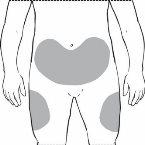
Лучше менять место инъекции каждый день, чтобы избежать риска болезненных ощущений в любом месте.
Необходимое оборудование для введения:
Для подкожного введения инъекции необходимы следующие элементы:
- Новый предзагруженный шприц Нивестима
- Контейнер для острых предметов (защищенный от проколов) для безопасной утилизации использованных шприцев
- Антисептические компрессы (если их рекомендует ваш врач или медсестра)
Как вводить подкожную инъекцию Нивестима?
- Попробуйте вводить инъекцию примерно в одно и то же время каждый день.
- Выньте упаковку с предзагруженным шприцем Нивестима из холодильника.
- Выньте блистер с предзагруженным шприцем из упаковки. Когда упаковка содержит несколько блистеров с предзагруженными шприцами, отрежьте блистер с предзагруженным шприцем вдоль перфорации, верните остальные блистеры с предзагруженными шприцами в упаковку и положите упаковку обратно в холодильник.
- Откройте блистер с предзагруженным шприцем, сняв крышку блистера. Выньте предзагруженный шприц из блистера, взяв его за корпус шприца.
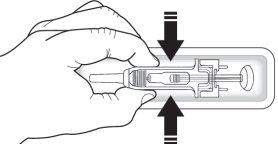
Проверьте шприц, чтобы убедиться, что защитный колпачок для иглы покрывает корпус предзагруженного шприца. Ненажимайте защитный колпачок для иглы на колпачок иглы до инъекции. Это может активировать или заблокировать защитный колпачок для иглы. Если защитный колпачок для иглы покрывает иглу, это означает, что он активирован.
Проверьте, что раствор прозрачный, бесцветный и практически не содержит видимых частиц. Неосматривайте продукт через пластиковую часть защитного устройства.
Проверьте дату на этикетке, чтобы убедиться, что лекарство не истекло.
Убедитесь, что у вас есть под рукой контейнер для острых предметов (защищенный от проколов).
Дайте предзагруженному шприцу достичь комнатной температуры (приблизительно 25 °C). Это займет 15-30 минут.
- Неснимайте колпачок иглы с шприца, пока предзагруженный шприц достигает комнатной температуры.
- Невстряхивайте шприц.
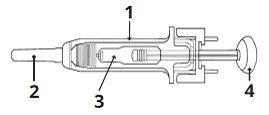
1 | Защитный колпачок для иглы |
2 | Колпачок иглы |
3 | Лекарство |
4 | Поршень |
- Не используйте шприц Нивестима, если:
- Картонная упаковка открыта или повреждена.
- Отсутствует защитный колпачок для иглы, он отсоединен или активирован.
- Лекарство мутное или изменило цвет, или в жидкости есть частицы.
- Какая-либо часть предзагруженного шприца треснута или сломана, или из шприца вытекла жидкость.
- Предзагруженный шприц упал. Предзагруженный шприц может быть сломан, даже если вы не видите трещин.
- Отсутствует колпачок иглы или он не установлен правильно.
- Дата истечения срока годности, напечатанная на этикетке, прошла.
Во всех этих случаях утилизируйте предзагруженный шприц и используйте новый предзагруженный шприц.
- Найдите удобное место для введения инъекции и проверьте дозу, которую вам назначили.
- Тщательно вымойте руки водой и мылом.
- Возьмите предзагруженный шприц за корпус защитного колпачка для иглы, с колпачком иглы, направленным вверх.
- Недержите шприц за головку поршня, поршень или колпачок иглы.
- Нетяните поршень назад в любой момент.
- Неснимайте колпачок иглы с предзагруженного шприца, пока не будете готовы ввести лекарство.
- Снимите колпачок иглы с шприца, держа корпус шприца, и осторожно потяните колпачок иглы наружу и подальше от вашего тела, не поворачивая его. Утилизируйте колпачок иглы. Ненадевайте колпачок иглы обратно. Ненажимайте поршень, нетрогайте иглу и невстряхивайте шприц.
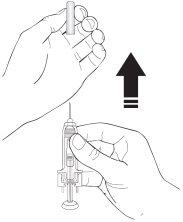
- Шприц теперь готов к использованию. Вы можете увидеть небольшую пузырьковую пробку в шприце. Вам не нужно удалять пузырьковую пробку перед введением раствора. Введение раствора с пузырьковой пробкой безвредно.
- Решите, где вы будете вводить инъекцию - найдите место на передней части живота или на передней части бедер. Каждый раз выбирайте разное место для инъекции. Невыбирайте область, которая чувствительна, покрасневшая, повреждена или имеет рубец. Очистите эту область кожи антисептической салфеткой.
- Зажмите кожу, стараясь не трогать очищенную область.
12 С другой руки держите предзагруженный шприц, как если бы он был карандашом. Используйте быстрое движение "дарта", чтобы вставить иглу под углом примерно 45° в кожу, как показано.
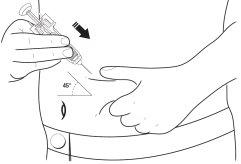
- Легко потяните поршень, чтобы подтвердить, что вы не попали в кровеносный сосуд. Если вы видите кровь в шприце, выньте иглу и вставьте ее в другое место. Держа кожу зажатой, медленно и равномерно нажмите поршень, пока содержимое шприца не будет полностью введено.
- После введения раствора выньте иглу из кожи.
- Убедитесь, что защитный колпачок шприца покрывает иглу в соответствии с инструкциями по активированию защитного колпачка шприца или пассивному защитному колпачку шприца, как указано ниже.
- Непытайтесь снова надеть колпачок иглы. Поместите шприц в контейнер для острых предметов (защищенный от проколов).
- Держите использованные шприцы вне досягаемости и виду детей.
- Никогдане кладите использованные шприцы в обычный домашний мусор.
Помните
Большинство людей могут научиться вводить себе подкожную инъекцию, но если вам очень трудно, не стесняйтесь просить о помощи и совете вашего врача или медсестры.
Использование активного сверхбезопасного защитного колпачка для иглы для Нивестима 12 МЕ/0,2 мл раствора для инъекции и для инфузии
Предзагруженные шприцы имеют активный сверхбезопасный защитный колпачок для иглы, чтобы защитить вас от уколов. Когда вы обращаетесь с предзагруженным шприцем, держите руки позади иглы.
- Сделайте инъекцию, используя описанную выше технику.
- Когда вы закончите инъекцию, скользите иглу внутрь защитного колпачка, пока игла не будет полностью закрыта (вы услышите "щелчок").

Использование пассивного сверхбезопасного защитного колпачка для иглы для Нивестима 30 МЕ/0,5 мл раствора для инъекции/инфузии и Нивестима 48 МЕ/0,5 мл раствора для инъекции/инфузии
Предзагруженные шприцы имеют пассивный сверхбезопасный защитный колпачок для иглы, чтобы защитить вас от уколов. Когда вы обращаетесь с предзагруженным шприцем, держите руки позади иглы.
- Сделайте инъекцию, используя описанную выше технику.
- Нажмите поршень, пока держите шприц пальцами, пока не будет введена полная доза. Пассивный защитный колпачок шприца неактивируется, пока небудет введена вся доза.

- Выньте иглу из кожи, и поршень переместится, позволяя шприцу переместиться вверх, пока игла не будет закрыта и заблокирована на месте.

--------------------------------------------------------------------------------------------------------------------
Эта информация предназначена только для врачей или медицинских работников:
Нивестим не содержит консервантов: в связи с возможным риском микробиологического загрязнения шприцы Нивестима предназначены для одноразового использования.
Случайное воздействие температуры замерзания в течение максимум 24 часов не влияет на стабильность Нивестима. Предзагруженные шприцы, подвергшиеся замерзанию, могут быть разморожены и затем охлаждены для будущего использования. Если воздействие было более 24 часов или если шприцы были заморожены более одного раза, то Нивестим недолжен быть использован.
Нивестим не должен быть разбавлен растворами хлорида натрия. Это лекарство не должно быть смешано с другими лекарствами, кроме тех, которые упоминаются ниже. Разбавленный филграстим может быть адсорбирован на пластиковых или стеклянных материалах, за исключением случаев, когда он разбавлен, как указано ниже.
Нивестим может быть разбавлен, если необходимо, в растворе глюкозы 5%. Не рекомендуется разбавлять до конечных концентраций ниже 0,2 МЕ (2 мкг) на миллилитр. Раствор должен быть визуально осмотрен перед использованием. Должны быть использованы только прозрачные растворы без частиц. У пациентов, леченных филграстимом, разбавленным до концентраций ниже 1,5 МЕ/мл (15 мкг/мл), должна быть добавлена человеческая альбуминовая сыворотка (АСГ) до конечной концентрации 2 мг/мл.
Пример: если объем инъекции составляет 20 мл, и общая доза филграстима ниже 30 МЕ (300 мкг), необходимо добавить 0,2 мл раствора человеческой альбуминовой сыворотки 200 мг/мл (20%). Когда Нивестим разбавляется в растворе глюкозы 5%, он совместим с стеклом и различными пластиками, включая поливинилхлорид, полиолефин (кополимер полипропилена и полиэтилена) и полипропилен.
После разбавления: было показано, что во время использования разбавленный раствор для инфузии остается физико-химически стабильным в течение 24 часов при 2-8°C. С микробиологической точки зрения продукт должен быть использован немедленно. Если он не используется немедленно, сроки хранения во время использования и условия, предшествующие ему, являются ответственностью пользователя и обычно не должны превышать 24 часа при 2-8°C, если только разбавление не было проведено в условиях асеپсии, проверенных и контролируемых.
- Страна регистрации
- Активное вещество
- Требуется рецептДа
- Производитель
- Информация носит справочный характер и не является медицинской рекомендацией. Перед приемом любых препаратов проконсультируйтесь с врачом. Oladoctor не несет ответственности за медицинские решения, принятые на основе этого контента.
- Аналоги НИВЕСТИМ 12 МЕ/0,2 мл РАСТВОР ДЛЯ ИНЪЕКЦИЙ ИЛИ ДЛЯ ПЕРФУЗИИФорма выпуска: ИНЪЕКЦИОННЫЙ РАСТВОР, 12 МЕ/0,2 млАктивное вещество: ФилграстимПроизводитель: Accord Healthcare S.L.U.Требуется рецептФорма выпуска: ИНЪЕКЦИОННЫЙ РАСТВОР, 0,3 мг / предварительно заполненный шприцАктивное вещество: ФилграстимПроизводитель: Accord Healthcare S.L.U.Требуется рецептФорма выпуска: ИНЪЕКЦИОННЫЙ РАСТВОР, 0,3 мг / предварительно заполненный шприцАктивное вещество: ФилграстимПроизводитель: Accord Healthcare S.L.U.Требуется рецепт
Аналоги НИВЕСТИМ 12 МЕ/0,2 мл РАСТВОР ДЛЯ ИНЪЕКЦИЙ ИЛИ ДЛЯ ПЕРФУЗИИ в других странах
Лучшие аналоги с тем же действующим веществом и терапевтическим эффектом.
Аналог НИВЕСТИМ 12 МЕ/0,2 мл РАСТВОР ДЛЯ ИНЪЕКЦИЙ ИЛИ ДЛЯ ПЕРФУЗИИ в Polónia
Аналог НИВЕСТИМ 12 МЕ/0,2 мл РАСТВОР ДЛЯ ИНЪЕКЦИЙ ИЛИ ДЛЯ ПЕРФУЗИИ в Ukraine
Врачи онлайн по НИВЕСТИМ 12 МЕ/0,2 мл РАСТВОР ДЛЯ ИНЪЕКЦИЙ ИЛИ ДЛЯ ПЕРФУЗИИ
Консультация по дозировке, побочным эффектам, взаимодействиям, противопоказаниям и продлению рецепта на НИВЕСТИМ 12 МЕ/0,2 мл РАСТВОР ДЛЯ ИНЪЕКЦИЙ ИЛИ ДЛЯ ПЕРФУЗИИ – по решению врача и с учетом местных правил.






